October's Recipe:
Beef Braised with Onions, Honey, and Bay Leaf
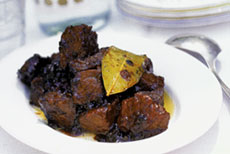
Makes 6 to 8 servings
|
|
Ingredients: |
| 2
pounds stewing beef, cut into 3-inch squares |
|
2 to 3 tablespoons
unsalted butter as needed |
| 2
large onions, finely chopped |
| 3
to 4 tablespoons extra virgin oil to taste |
|
Salt |
|
1/2 teaspoon whole black
peppercorns |
| 2
cups dry white wine |
| 1
bay leaf |
| 3
tablespoons honey, preferably Greek thyme honey |
Preparation:
|
1. Rinse and pat
dru the meat. Set aside.
2. Heat the butter in a large, wide pot over
low heat and cook the onions until they wilt, or 12
to 15 minutes. Remove with a slotted spoon and
set aside.
3. Add the oil to the pot, increase the heat
to high, and brown the meat, turning so as to color
on all sides. Add the onions back to the pot,
season with salt, and stir to combine. Add the
peppercorns, wine and bay leaf. Cover and
bring to a boil. Reduce the heat to very low
and let the meat simmer slowly for about 2 and half
hours. Add water during cooking as needed to
keep the contents of the pot moist. By the end
of the cooking, the meat and its sauce will have
turned a luscious deep dark brown and the pan juices
will thicken considerably. Remove and serve.
|
"The
meat in this dish turns a deep dark brown because of
the honey that caramelized in the pot. It's a
lovely meze. Try serving it spooned onto endive,
radicchio, or Bibb lettuce leaves. It's a perfect
match for some of the blended red wines that Greece is
now producing."
|
Excerpts from:
"MEZE", by Diane Kochilas
Are you missing some pices and incredients for your
recipe?
|
|
|
Watch Your Manners In Greece |
|
Engagement and Marriage (Part III) |
|
Continued from
September's Issue...
- On leaving the church, relatives or friends hand
guests a reminiscent gift (sugared almonds wrapped
in a veil cloth).
- According to custom, young unmarried women place
these almonds underneath their pillow that night so
they may dream of their future husband.
- Since the wedding, from legal point of view, is a
civil pact, the couple must sign certain documents
in order to receive the wedding certificate.
- The bride's bouquet was initially a small bunch of
herbs, which served to keep all evil spirits away.
- Interestingly, as nowadays the amount of money
spent on the wedding ceremony decreases, the cost of
the reception increases.
- Traditionally, wedding ceremonies used to take
place at the bride's paternal house. This tradition,
of course, began at a time when brides used to live
with their parents until their wedding day.
- If the reception takes place at the house of
either of the couple's parents, they should refrain
from sleeping there as it is considered bad luck.
They should opt for a hotel or their own new home.
- Wedding receptions began in the Middle Ages when
the groom had to prove that he could sustain his
wife; consequently he offered her family presents,
food and drinks.
- Nowadays, wedding receptions may take place in
hotels, country estates or at a friend's or a
relative's house.
- During the reception a couple may wish to choose
either a contemporary or classical song for their
first dance, or they may opt for a traditional
folkloric Greek song.
- The cutting of the wedding cake ensures a fertile
marriage. Cake is offered not just to friends and
relatives, but also to each member of the staff who
helped during the reception.
- In some areas of Greece (especially Crete), there
is a tradition of gun firing during receptions (an
indication of unrestrained joy!); however, due to
some unfortunate accidents in the past, this is not
advisable.
- Not anyone can get married: there are some legal
issues concerning marriage in Greece. The age of
consent is 18. If someone younger wishes to marry,
then parental permission is necessary.
- Couples who are closely related by blood or
adoption are not allowed to marry each other.
- Traditionally, a wedding day is dedicated to the
bride. This means that she is the one who usually
chooses the religion and type of ceremony.
- If the couple come from different religions, there
may be two religious ceremonies, so that both parts
feel content.
- The couple may choose the church of their
preference and must meet the priest in advance.
Together they make all necessary arrangements.
- Although no dowry is necessary nowadays, the
bride's parents still have certain obligations. They
arrange and pay for the newspaper announcement and
help the groom's parents make up the guest list.
They pay for the decoration of the church and for
everything concerning the wedding reception (i.e.
food, drinks, cake, flowers, decoration,
photographers and music).
- Of course any contribution from the couple itself,
the grandparents, the groom's family or other
relatives are welcome.
- The groom's family has not many obligations. They
usually pay for the wedding dress, which has been
picked by the bride.
- The best man's presence is of great importance. He
is usually a close friend or relative.
Traditionally, either the best man or maid of honour
was the godfather/godmother of the bride.
- In Greece it is not customary for the best man to
make a speech, although if he wishes he may do so.
- Apart from the flowers, the church's expenses are
usually paid by the best man.
- After their wedding, women are allowed to keep
their maiden name or use both names adding a hyphen
in between.
- If it all comes to an end, applying for a divorce
in Greece must be done no sooner than six months
after the wedding ceremony. After the first
application has been submitted, another must be
submitted six months later. The court's decision may
take one or even two years, depending on the court's
workload.
Excerpt from "Watch Your Manners In Greece" by
Christos K. Zampounis
|
|
|
|
Special Feature: Mastic
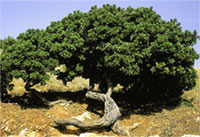 Below
the low, sclerophyllous evergreen growth of
the maquis tree, the form of vegetation that
is so characteristic of the Mediterranean
area, there is a shrub which only occurs on
the south of the island of Chios. This is
the subspecies Pistacia lentiscus var. chic,
the mastic bush. When its bark is damaged,
it exudes a sweet smelling, white,
transparent resin, already much prized in
ancient times. It was particularly valued
for its stickiness, which is preserved,
indeed only really develops, when a lump of
resin is chewed. So it was used very early
on, mainly for oral hygiene. Dioskourides
refers to it in his pharmacology as a
cosmetic substance. Because of its scent it
was used in perfumes and as incense for
improving the air. The oil obtained from the
resin was used to ward off colds, coughs,
and sneezes. Below
the low, sclerophyllous evergreen growth of
the maquis tree, the form of vegetation that
is so characteristic of the Mediterranean
area, there is a shrub which only occurs on
the south of the island of Chios. This is
the subspecies Pistacia lentiscus var. chic,
the mastic bush. When its bark is damaged,
it exudes a sweet smelling, white,
transparent resin, already much prized in
ancient times. It was particularly valued
for its stickiness, which is preserved,
indeed only really develops, when a lump of
resin is chewed. So it was used very early
on, mainly for oral hygiene. Dioskourides
refers to it in his pharmacology as a
cosmetic substance. Because of its scent it
was used in perfumes and as incense for
improving the air. The oil obtained from the
resin was used to ward off colds, coughs,
and sneezes.
In the Middle Ages, it was the Genoese in
particular who carried on the trade in
mastic throughout the Mediterranean area and
helped the island to achieve relative
prosperity. During the time of Ottoman rule
on Chios, the Sultan permitted the
inhabitants to continue the mastic trade
virtually unhindered. However, instead of
taxes he demanded an annual tribute of half
the production of this valuable raw
material, a large part of which ended up in
the seraglio in Istanbul, the sultan's
harem, where it was used as chewing gum. In
addition, mastic soon found a use as a food
additive. Though the mastic farmers of Chios
were highly regarded throughout the Middle
Ages in Greece, the few farmers left today
must fight for survival. Even if growing
conditions on Chios are good for the shrub,
and the resin is still used, it is under
increasing pressure from synthetic resins,
except for flavoring the ouzo produced on
the island. The resin, which is traded in
the form of a firm, granular material, is
used among other things as an element in the
formulation of adhesives, special cements
and varnishes, and as an aromatic additive
to incense, toothpaste, and chewing gum
(Greek: mastikha). Mastic has an unusually
intense taste and a fragrant, flowery aroma
and is therefore used in various Greek and
oriental sweets or confections such as
khalvas and loukotimia.
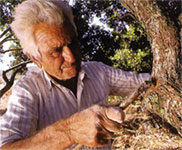 |
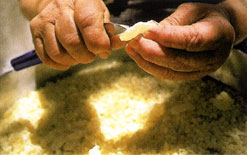 |
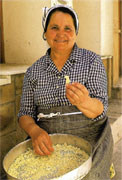 |
The
much praised resin
flows from the cuts |
The
surface of the mastic crystal is
cleaned with a pointed knife |
The
pieces of collected resin come in
different shapes and sizes |
Mastic collecting begins in the middle of
August, when up to eight cross-shaped cuts
are made in the bark, so the resin can flow
out and set. It takes about 15 days to dry
before it can be collected. The grains of
mastic are sifted to remove pollutants such
as sand, then it is washed with cold water
and soap, and laid out to dry. At the same
time, the last particles of dirt are
scratched off with a knife. Finally, it is
sifted again, during which the individual
lumps or "tears" of resin are sorted
according to quality and size.
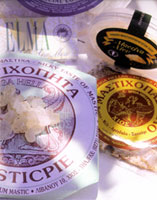 |
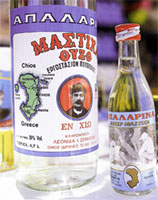 |
|
mastic
flavored candies |
where
anise once provided the taste,
sweet mastic is the predominant
flavor in Chios Clear |
excerpts from:
"Culinaria
Greece"
|
|
|
What's
New!!! |
|
Greek
CDs & DVDs |
|
|
|
Books |
|
|
|
Children's
Books in Greek or in English |
|
|
|
Magnets & Accesories |
|
|
|
Featured Destination: Hydra |
|
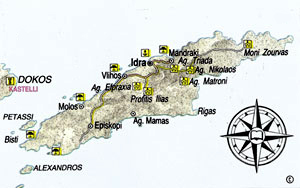 GEOGRAPHY. With its cosmopolitan atmosphere and
constant throng of tourists, Hydra is quite unlike the
other islands of the
Argosaronic gulf. 50 sq. km. in area, with 56 km. of
coast and 2,723 inhabitants, its main town is also
called Hydra. There are daily boat and hydrofoil
connections with Piraeus, 36 nautical miles away, as
well as with Aegina, Methana, Poros, Spetses and
Hermione. During the summer there is a hydrofoil link
with Tolo, Nauplion and Porto Cheli, and twice a week
with Monemvasia and Leonidion. Tourist facilities are of
a high standard and there is a yacht marina in the
harbour. Hydra is also exceptional on account of its
unique landscape, differing from that of the other
islands in that it is rocky and barren (highest point
Eros, 593 m. a.s.l.). GEOGRAPHY. With its cosmopolitan atmosphere and
constant throng of tourists, Hydra is quite unlike the
other islands of the
Argosaronic gulf. 50 sq. km. in area, with 56 km. of
coast and 2,723 inhabitants, its main town is also
called Hydra. There are daily boat and hydrofoil
connections with Piraeus, 36 nautical miles away, as
well as with Aegina, Methana, Poros, Spetses and
Hermione. During the summer there is a hydrofoil link
with Tolo, Nauplion and Porto Cheli, and twice a week
with Monemvasia and Leonidion. Tourist facilities are of
a high standard and there is a yacht marina in the
harbour. Hydra is also exceptional on account of its
unique landscape, differing from that of the other
islands in that it is rocky and barren (highest point
Eros, 593 m. a.s.l.).
HISTORY. It was known in antiquity as Hydraia and
there was a Mycenaean settlement to the west of the
present town, as excavations have revealed.
In Homeric times it was dependent on Mycenae and later
on Hermione which, according to Herodotus, sold the
island for 100 talants to exiled Samians. It seems that
during the Byzantine era it experienced a floruit, as
evident from finds at the locality of Episkopi on the
island's east coast. However, its greatest acme was
achieved in more recent times, particularly during the
17th and 18th century when its inhabitants amassed a
considerable fleet of vessels, both large and small,
which voyaged throughout the Mediterranean. This fleet
and its experienced crews comprised the Hydriote
contribution to the Struggle for Independence in 1821.
The island's nautical tradition continued into modern
times even though many of its inhabitants moved to
Piraeus or emigrated to America. Nowadays there is a
Merchant Navy Academy here.
SIGHTS-MONUMENTS. The old harbour with its canons
and imposing bourgeois residences dominating the
landscape also bear witness to its great maritime
tradition. The houses are built amphitheatrically, many
have been refurbished in the original style and have
preserved their interior decoration, often reminiscent
of renaissance mansions in miniature. Of these the
Voulgari mansion on the west flank of the harbour, that
of Kountouriotis further up, Tombazis' adjacent to that
of Voulgaris, as well as those of Votsi and Koulouris
are particularly impressive. A branch of the School of
Fine Arts is accommodated in the Tombazis mansion, a
Home for the Aged in that of Kriezis and the Merchant
Navy Academy in the Tsambados residence. The Museum
houses archival material related to the 1821 Revolution.
Of the many important churches and monasteries on the
island, mention should be made of the cathedral
(metropolis), dedicated to the Dormition of the Virgin
and built in 1765, with its marble iconostasis and
numerous icons (including one the Neomartyr Constantine
of Hydra). On the east side of the island, beside the
bay of Mandraki (3 km. from the harbour) stands the
monastery of the Holy Trinity and to the northeast that
of St. Nicholas and St. Matrona, on the highest peak of
the island the monasteries of Prophet Elijah (circa
1800) and St. Eupraxia (circa 1800). Next to the
lighthouse (Faros) (at the northeast tip of the island)
is the monastery of the Dormition or the Virgin Zourva.
The regions of Kaminia, Vlychos and Molos are
particularly picturesque and from here one can climb up
to Episkopi (on the south side), site of the Byzantine
town. In general only a few beaches are suitable for
swimming (Mandraki, Kaminia, Viychos, Molos, Bisti) and
access to these is by small boat. There are refuelling
facilities in the harbour. Visitors may stay in hotels
(mostly in town) and a limited number of rooms and
apartments for rent. Hydra is girt by numerous rocky
islets, the largest of which is Dokos. |
|
|
|
Travel
Guides and Information for your trip in the area |

Going to Live and Work in Greece
2005 edition |

Let's Go Greece 2005 edition - 20% off |

Greece Road Map Set - 10 maps |

Greece - A Guide to the
Archaeological Sites - Travel Guide |

Cruise Greece DVD |
| |
|
Saints'
Namedays in
October |
|
Monday |
Tuesday |
Wednesday |
Thursday |
Friday |
Saturday |
Sunday |
|
|
|
|
|
|
1
Ananiou / Pomanou Melodou |
2
Kuprianou / Ioustiounis |
3
Dionisiou Aeropagitou |
4
Ierotheou |
5
Xaritinis |
6
Thoma |
7
Poluxroniou |
8
Iakovou
|
9
Eulampiou |
|
10
|
11 |
12 |
13 |
14 |
15
Loukianou
|
16 |
17
|
18
Louka |
19
Kleopatras |
20
Artemiou / Gerasimou Kefallhnias
|
21
Sokratous |
22 |
23
Iakovou |
24
Sevastianis |
25
|
26
Dimitriou Myrovlitou
|
27
Nestoros |
28
Agias Skepis |
29
|
30
Zinoviou |
31
|
|
|
|
|
|
|
|
|
Icons
depicting the celebrated Saint, make great gifts for
namedays.
Shop among our great collection of icons at our
store. Also available, namedays, birthday, holiday, and
special occasion greeting cards.
|
|
Share
With Others!!!! |
Let your family and friends share the savings by
forwarding them this email.
|
|
Suggestions
& Comments |
Dear Greekshops.com customer,
Thank you for contributing to our effort to bring
unique and hard to find Greek products to your home. We
value your opinion, so please let us know if you have
any concerns, suggestions, comments that will improve
and help us grow. Send us your feedback at:
[email protected]
|
|
Subscription
Information |
|
Missed an issue of our
newsletter? Now you can access past newsletters by
visiting
http://www.greekshops.com/newsletters_archive
To
unsubscribe from this email list please reply back
to this email and change the Subject of your email
to REMOVE. You can also unsubscribe by
clicking here
|
|
|
|

